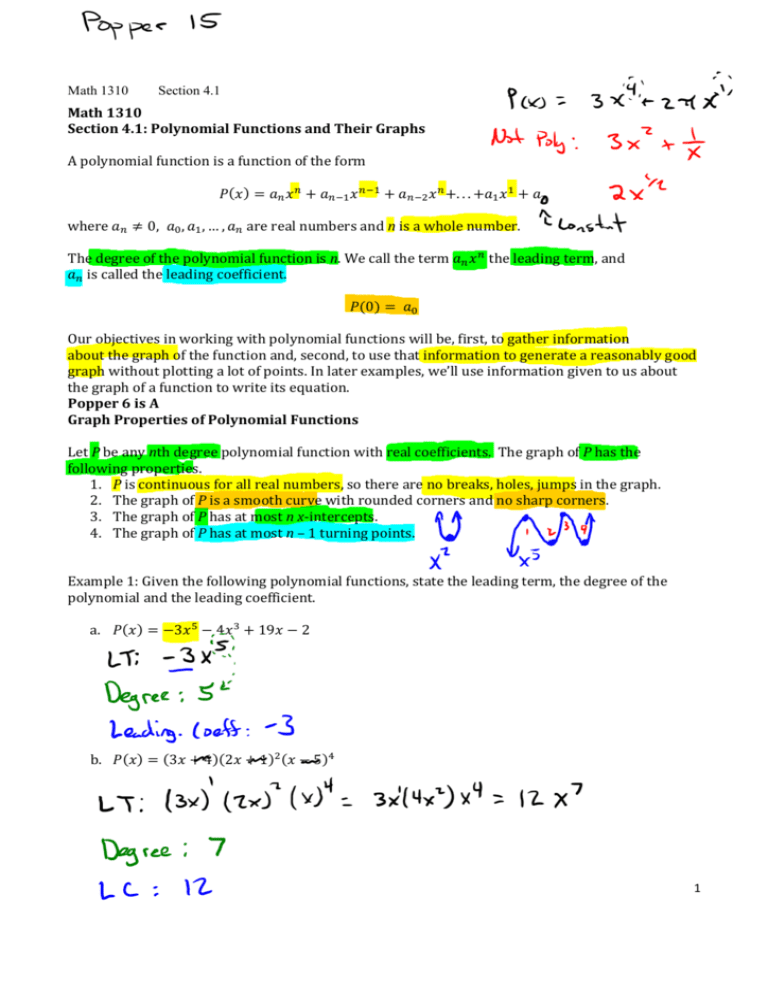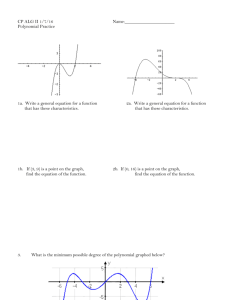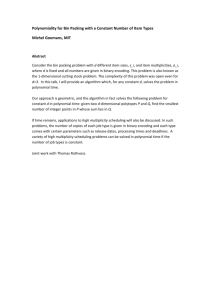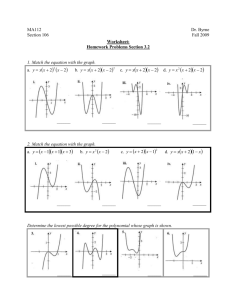Math 1310 Section 4.1: Polynomial Functions and Their Graphs A
advertisement

Math 1310 Section 4.1 Math 1310 Section 4.1: Polynomial Functions and Their Graphs A polynomial function is a function of the form ܲሺ ݔሻ = ܽ ݔ + ܽିଵ ݔିଵ + ܽିଶ ݔ +. . . +ܽଵ ݔଵ + ܽ where ܽ ≠ 0, ܽ , ܽଵ , … , ܽ are real numbers and n is a whole number. The degree of the polynomial function is n. We call the term ܽ ݔ the leading term, and ܽ is called the leading coefficient. ܲሺ0ሻ = ܽ Our objectives in working with polynomial functions will be, first, to gather information about the graph of the function and, second, to use that information to generate a reasonably good graph without plotting a lot of points. In later examples, we’ll use information given to us about the graph of a function to write its equation. Popper 6 is A Graph Properties of Polynomial Functions Let P be any nth degree polynomial function with real coefficients. The graph of P has the following properties. 1. P is continuous for all real numbers, so there are no breaks, holes, jumps in the graph. 2. The graph of P is a smooth curve with rounded corners and no sharp corners. 3. The graph of P has at most n x-intercepts. 4. The graph of P has at most n – 1 turning points. Example 1: Given the following polynomial functions, state the leading term, the degree of the polynomial and the leading coefficient. a. ܲሺݔሻ = −3 ݔହ − 4 ݔଷ + 19 ݔ− 2 b. ܲሺ ݔሻ = ሺ3 ݔ+ 4ሻሺ2 ݔ+ 1ሻଶ ሺ ݔ− 5ሻସ 1 Math 1310 Section 4.1 Popper 1: State the degree of the following function ܲሺݔሻ = ሺ ݔ+ 4ሻሺ ݔ+ 2ሻሺ ݔ− 3ሻଷ a. b. c. d. 2 3 5 6 We’ll start with the shapes of the graphs of functions of the form ݂ ሺ ݔሻ = ݔ , ݊ > 0. You should be familiar with the graphs of ݂ ሺ ݔሻ = ݔଶ and ݃ሺݔሻ = ݔଷ . The graph of ሺ ݔሻ = ݔ , ݊ > 0. , n is even, will resemble the graph of ݂ ሺݔሻ = ݔଶ , and the graph of ݂ ሺ ݔሻ = ݔ , ݊ > 0, n is odd, will resemble the graph of ݂ ሺݔሻ = ݔଷ . Next, you will need to be able to describe the end behavior of a function. End Behavior of Polynomial Functions The behavior of a graph of a function to the far left or far right is called its end behavior. The end behavior of a polynomial function is revealed by the leading term of the polynomial function. 2 Math 1310 Section 4.1 1. Even-degree polynomials look like . = ݕ± ݔଶ 2. Odd-degree polynomials look like. = ݕ± ݔଷ Next, you should be able to find the x intercept(s) and the y intercept of a polynomial function. Zeros of Polynomial Functions You will need to set the function equal to zero and then use the Zero Product Property to find the x-intercept(s). That means if ab = 0, then either a = 0 or b = 0 . To find the y intercept of a function, you will find f (0). Example 2: Find the zeros of: a. ݂ሺ ݔሻ = ݔ− ݔସ 3 Math 1310 Section 4.1 ଼ b. ݂ሺ ݔሻ = −3 ݔቀ ݔ− ቁ ሺ ݔ+ 2ሻଷ In some problems, one or more of the factors will appear more than once when the function is factored. The power of a factor is called its multiplicity. So given ሺݔሻ = ݔଷ ሺ ݔ− 3ሻଶ ሺ ݔ+ 2ሻଵ , then the multiplicity of the first factor is 3, the multiplicity of the second factor is and the multiplicity of the third factor is 1. Description of the Behavior at Each x-intercept 1. Even Multiplicity: The graph touches the x-axis, but does not cross it. It looks like a parabola there. 2. Multiplicity of 1: The graph crosses the x-axis. It looks like a line there. 3. Odd Multiplicity greater than or equal 3: The graph crosses the x-axis. It looks like a cubic there. You can use all of this information to generate the graph of a polynomial function. · degree of the function · end behavior of the function · x and y intercepts (and multiplicities) · behavior of the function through each of the x intercepts (zeros) of the function Steps to graphing other polynomials: 1. Determine the leading term. Is the degree even or odd? Is the sign of the leading coefficient positive or negative? 2. Determine the end behavior. Which one of the 4 cases will it look like on the ends? 3. Factor the polynomial. 4. Make a table listing the factors, x intercepts, multiplicity, and describe the behavior at each x intercept. 5. Find the y- intercept. 6. Draw the graph, being careful to make a nice smooth curve with no sharp corners. Note: without calculus or plotting lots of points, we don’t have enough information to know how high or how low the turning points are 4 Math 1310 Section 4.1 Example 3: Find the x and y intercepts. State the degree of the function. Sketch the graph of ݂ሺ ݔሻ = 4 ݔଷ + 8 ݔଶ + 4ݔ Popper 2: State the y-intercept of the function. ܲሺ ݔሻ = −ሺ ݔ+ 4ሻሺ ݔ− 1ሻଶ ሺ ݔ− 2ሻଷ a. b. c. d. 16 -16 32 -32 Popper 3: The function above has which type of end behavior? a. b. c. d. Both Up Both Down Bottom to Top Top to Bottom 5 Math 1310 Section 4.1 Example 4: Find the x and y intercepts. State the degree of the function. Sketch the graph of ܲሺ ݔሻ = ሺ ݔ− 4ሻଶ ሺ ݔ− 1ሻହ ሺ ݔ+ 2ሻସ Example 5: Find the x and y intercepts. State the degree of the function. Sketch the graph of ݃ሺ ݔሻ = ሺ4 − ݔሻሺ ݔ+ 2ሻሺ ݔ+ 5ሻଶ 6 Math 1310 Section 4.1 Example 6: Find the x and y intercepts. State the degree of the function. Sketch the graph of ݂ሺݔሻ = ሺ ݔ− 3ሻଶ ሺ− ݔ+ 2ሻଷ ሺ ݔ+ 5ሻ Popper 5 is D Example 7: Write the equation of the cubic polynomial P(x) that satisfies the following conditions: zeros at x = 3, x = -1, and x = 4 and passes through the point (-3, 7) 7 Math 1310 Section 4.1 Example 8: Write the equation of the quartic function with y intercept -4 which is tangent to the x axis at the points (-2, 0) and (1, 0). 8







